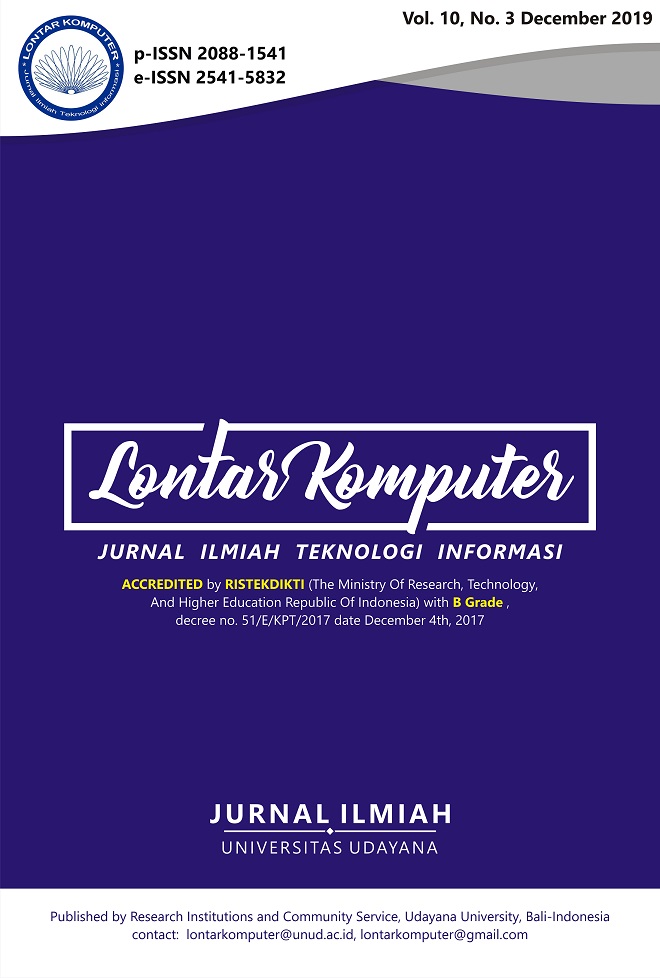Performance Analysis of Point-to-Point LoRa End Device Communication
Abstract
LoRa is an emerging communication technology that can be used in any field. Many types of research have analyzed LoRa network using a gateway and several end devices to many monitoring applications. However, the communication performance between LoRa end devices only has not been evaluated. This research tested a LoRa communication between two end devices in a point-to-point topology. From the experiment results with various payload lengths, the optimum payload is only 48 bytes with the default module configuration. Longer payload resulted in a decreased performance. Thus, this research implemented a waiting protocol that can increase the Packet Reception Ratio of 100-byte payload from 49.87% to 97.52%.
Downloads
References
[2] M. C. Krutwig, B. Kolmel, A. D. Tantau and K. Starosta, “Standards for Cyber-Physical Energy Systems – Two Case Studies from Sensor Technology” Applied Sciences, vol. 9, no. 3, p. 435, 2019.
[3] D. Sasmoko and D. Bachtiar, “Intelligent Baby Box Based on IoT to Observe Room Temperature and Baby Crying” Lontar Komputer, vol. 9, no. 3, pp. 114-123, 2018.
[4] Semtech Corporation, SX1276/77/78/79 Datasheet, Revision 4, March 2015.
[5] A. Augustin, J. Yi, T. Clausen and W. M. Townsley, “A Study of LoRa: Long Range & Low Power Networks for the Internet of Things” Sensors, vol. 16, no. 9, p. 1466, 2016.
[6] P. A. Catherwood, D. Steele, M. Little, S. McComb and J. McLaughlin, “A Community-Based IoT Personalized Wireless Healthcare Solution Trial” IEEE Journal of Translational Engineering in Health and Medicine, vol. 6, pp. 1-13, 2018.
[7] F. Wu, J-M Redoute and M. R. Yuce, “WE-Safe: A Self-Powered Wearable IoT Sensor Network for Safety Applications Based on LoRa” IEEE Access, vol. 6, pp. 40846-40853, 2018.
[8] M. Petric, J. Vandendriessche, C. Marsboom, T. Matheussen, E. Ducheyne and A. Touhafi, “Autonomous Wireless Sensor Networks in an IPM Spatial Decision Support System” Computers, vol. 8, no. 2, p. 43, 2019.
[9] C. Ebi, F. Schaltegger, A. Rust and F. Blumensaat, “Synchronous LoRa Mesh Network to Monitor Processes in Underground Infrastructure” IEEE Access, vol. 7, pp. 57663-57677, 2019.
[10] S. Rinaldi, M. Pasetti, E. Sisinni, F. Bonafini, P. Ferrari, M. Rizzi and A. Flammini, “On the Mobile Communication Requirements for the Demand-Side Management of Electric Vehicles” Energies, vol. 11, no. 5, p. 1220, 2018.
[11] J. C. Ferreira, J. A. Afonso, V. Monteiro and J. L. Afonso, “An Energy Management Platform for Public Buildings” Electronics, vol. 7, no. 11, p. 294, 2018.
[12] M. C. Tome, P. H. J. Nardelli and H. Alves, “Long-range Low-power Wireless Networks and Sampling Strategies in Electricity Metering” IEEE Transactions on Industrial Electronics, vol. 66, no. 2, pp. 1629-1637, 2019.
[13] R. Sanchez-Iborra, J. Sanchez-Gomez, J. Ballesta-Viñas, M-D Cano and A. F. Skarmeta, "Performance Evaluation of LoRa Considering Scenario Conditions" Sensors, vol. 18, no. 3, p. 772, 2018.
[14] R. El Chall, S. Lahoud and M. El Helou, “LoRaWAN Network: Radio Propagation Models and Performance Evaluation in Various Environments in Lebanon” IEEE Internet of Things Journal, vol. 6, no. 2, pp. 2366-2378, 2019.
[15] A. Ciuffoletti, “Low-Cost IoT: A Holistic Approach” Journal of Sensor and Actuator Networks, vol. 7, no. 2, p. 19, 2018.
[16] S. Hosseinzadeh, M. Almoathen, H. Larijani and K. Curtis, “A Neural Network Propagation Model for LoRaWAN and Critical Analysis with Real-World Measurements” Big Data and Cognitive Computing, vol. 1, no. 1, p. 7, 2017.
[17] Ministry of Communication and Informatics, “Persyaratan Teknis Alat dan/atau Perangkat Telekomunikasi Low Power Wide Area” Regulation of the General Director of Resources and Devices of Post and Informatics, no.3, 2019.
The Authors submitting a manuscript do so on the understanding that if accepted for publication, the copyright of the article shall be assigned to Jurnal Lontar Komputer as the publisher of the journal. Copyright encompasses exclusive rights to reproduce and deliver the article in all forms and media, as well as translations. The reproduction of any part of this journal (printed or online) will be allowed only with written permission from Jurnal Lontar Komputer. The Editorial Board of Jurnal Lontar Komputer makes every effort to ensure that no wrong or misleading data, opinions, or statements be published in the journal.
 This work is licensed under a Creative Commons Attribution 4.0 International License.
This work is licensed under a Creative Commons Attribution 4.0 International License.























